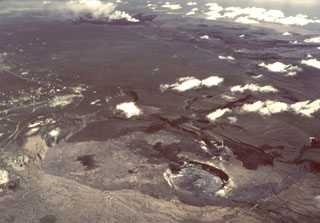Report on Kilauea (United States) — 3 June-9 June 2009
Smithsonian Institution / US Geological Survey
Weekly Volcanic Activity Report, 3 June-9 June 2009
Managing Editor: Sally Sennert.
Please cite this report as:
Global Volcanism Program, 2009. Report on Kilauea (United States) (Sennert, S, ed.). Weekly Volcanic Activity Report, 3 June-9 June 2009. Smithsonian Institution and US Geological Survey.
Kilauea
United States
19.421°N, 155.287°W; summit elev. 1222 m
All times are local (unless otherwise noted)
During 3-9 June, HVO reported that lava flowed SE from underneath Kilauea's Thanksgiving Eve Breakout (TEB) and rootless shield complex through a lava tube system, reaching the Waikupanaha ocean entry. The Kupapa'u ocean entry was again active starting on 4 or 5 June. Thermal anomalies detected in satellite images and visual observations revealed active surface flows above and in the abandoned Royal Gardens subdivision, and on the TEB flow field.
The vent in Halema'uma'u crater continued to produce a predominantly white plume that drifted mainly SW. Small amounts of tephra, including Pele's hair and fresh spatter, were retrieved from collection bins placed near the plume during the reporting period. A molten lava pool near the base of the cavity, about 100 m below the floor of the crater, produced bright incandescence. Lava was clearly visible in the Halema'uma'u Overlook Vent webcam on 5 June. On 8 and 9 June, sounds resembling rushing gas and rockfalls were heard in the vicinity of the crater. The sulfur dioxide emission rate at the summit remained elevated; measurements were 700 and 800 tonnes per day on 4 and 5 June, respectively. The 2003-2007 average rate was 140 tonnes per day.
Geological Summary. Kilauea overlaps the E flank of the massive Mauna Loa shield volcano in the island of Hawaii. Eruptions are prominent in Polynesian legends; written documentation since 1820 records frequent summit and flank lava flow eruptions interspersed with periods of long-term lava lake activity at Halemaumau crater in the summit caldera until 1924. The 3 x 5 km caldera was formed in several stages about 1,500 years ago and during the 18th century; eruptions have also originated from the lengthy East and Southwest rift zones, which extend to the ocean in both directions. About 90% of the surface of the basaltic shield volcano is formed of lava flows less than about 1,100 years old; 70% of the surface is younger than 600 years. The long-term eruption from the East rift zone between 1983 and 2018 produced lava flows covering more than 100 km2, destroyed hundreds of houses, and added new coastline.
Source: US Geological Survey Hawaiian Volcano Observatory (HVO)

